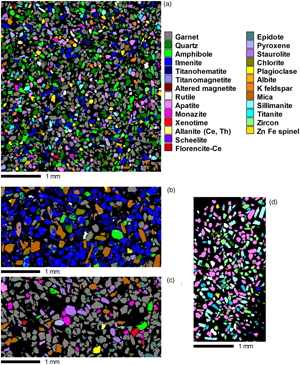Article contents
Deciphering the Complex Mineralogy of River Sand Deposits through Clustering and Quantification of Hyperspectral X-Ray Maps
Published online by Cambridge University Press: 14 April 2020
Abstract

Alluvial mineral sands rank among the most complex subjects for mineral characterization due to the diverse range of minerals present in the sediments, which may collectively contain a daunting number of elements (>20) in major or minor concentrations (>1 wt%). To comprehensively characterize the phase abundance and chemistry of these complex mineral specimens, a method was developed using hyperspectral x-ray and cathodoluminescence mapping in an electron probe microanalyser (EPMA), coupled with automated cluster analysis and quantitative analysis of clustered x-ray spectra. This method proved successful in identifying and quantifying over 40 phases from mineral sand specimens, including unexpected phases with low modal abundance (<0.1%). The standard-based quantification method measured compositions in agreement with expected stoichiometry, with elemental detection limits in the range of <10–1,000 ppm, depending on phase abundance, and proved reliable even for challenging mineral species, such as the multi-rare earth element (REE) bearing mineral xenotime [(Y,REE)PO4] for which 24 elements were analyzed, including 12 overlapped REEs. The mineral identification procedure was also capable of characterizing mineral groups that exhibit significant compositional variability due to the substitution of multiple elements, such as garnets (Mg, Ca, Fe, Mn, Cr), pyroxenes (Mg, Ca, Fe), and amphiboles (Na, Mg, Ca, Fe, Al).
Keywords
- Type
- Australian Microbeam Analysis Society Special Section AMAS XV 2019
- Information
- Copyright
- Copyright © Microscopy Society of America 2020
References
- 13
- Cited by





